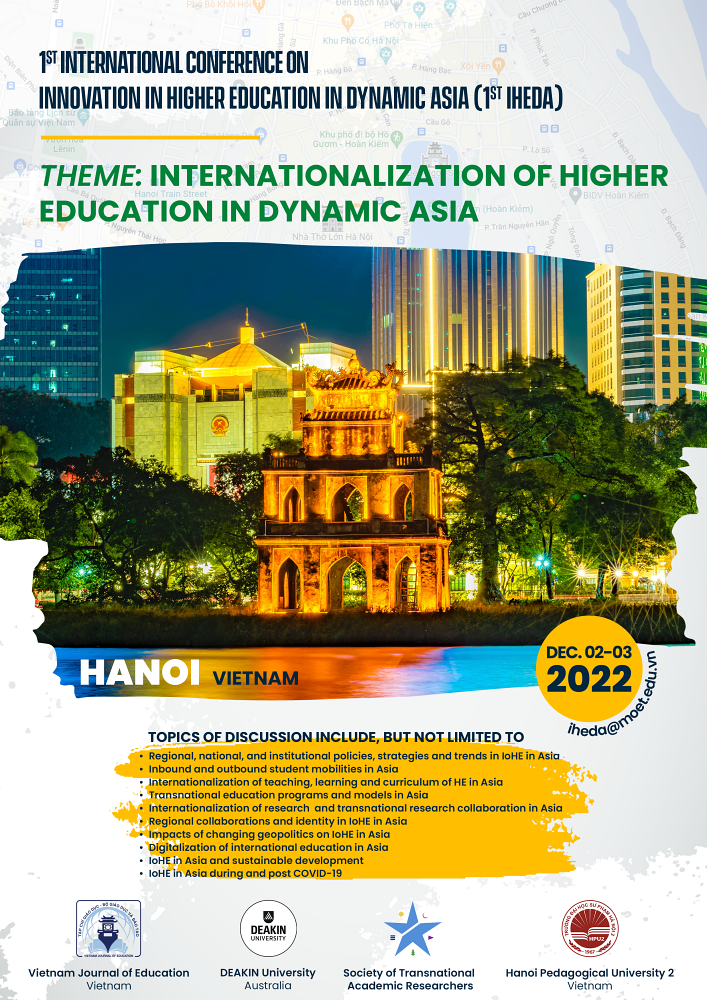Motivation in Foreign Language Classrooms at Tertiary Level: A Case Study
DOI:
https://doi.org/10.52296/vje.2021.72-
Downloads
How to Cite
Abstract
In teaching and learning a foreign language, especially English, motivation plays an extremely integral part in ensuring success. In this study, the researchers attempt to provide an overview of research on motivation and discover how motivation can assist second or foreign language learning in classrooms of English-majored students in the university setting. This study aims to investigate whether English-majored learners are motivated in learning English or not, focusing on extrinsic motivational factors to identify the factors to develop their motivation and maintain their journey of learning English. A questionnaire is devised and administered to 52 senior English-majored students. The data was then analyzed using the SPSS version 20. The results suggest that learners’ motivation is related to learning facilities and teacher’s personality which can encourage learners to think more positively and thus be more motivated in their language learning process. Along with providing specific recommendations for further research on motivation, the paper concludes by calling on for adopting a range of motivational factors that can promote English as a foreign or second language learning.
Downloads
References
Berges-Puyó, J. G. (2018). Motivational factors in learning an L2: A study on intrinsic/extrinsic motivation, classroom materials and teacher’s behaviors. Retrieved from https://www.researchgate.net/publication/325204332_Motivational_factors_in_learning_an_L2_a_study_on_intrinsicextrinsic_motivation_classroom_materials_and_teacher%27s_behaviors
Bernaus, M. & Gardner, R. C. (2008). Teacher motivation strategies, student perceptions, student motivation, and English achievement. The Modern Language Journal, 92, 389-401.
Black, A. E., & Deci, E. L. (2000). The effects of instructors’ autonomy support and students’ autonomous motivation on learning organic chemistry: A self-determination theory perspective. Science Education, 84, 740-756.
Branch, L. (2016). The impact of motivation on English language learning. International Journal of Research in English Education, 1(1), 11-15.
Brown, H. D. (2000). Principles of language learning and teaching (4th Ed.). International Journal of Research in English Education. Englewood Cliffs NJ: Prentice-Hall.
Broussard, S. C., & Garrison, M. E. B. (2004). The relationship between classroom motivation and academic achievement in elementary school-aged children. Family and Consumer Sciences Research Journal, 33(2), 106-120.
Brown, H. D. & Gonzo, T. (1995). Principles of languages teaching and learning. San Francisco: Prentice Hall Regents.
Crookes, G., & Schmidt, R. W. (1991). Motivation: Reopening the research agenda. Language Learning, 41, 469-512.
Ditual, R. C. (2012). The motivation for and attitude towards learning English. Asian EFL Journal, 63, 12-14.
Dörnyei, Z. (1996). Moving language learning motivation to a longer platform for theory and practice. In: Oxford.
Dörnyei, Z. (1998). Conceptualizing motivation in foreign language learning. Language Learning, 40, 46-78.
Dörnyei, Z. (2001). Teaching and researching: Motivation. London: Routledge.
Ellliot, A. J. & Covington, M. (2001). Approach and avoidance motivation. Educational Psychology Review, 13(2). 23-24.
Falk, J. (1978). Linguistics and language: A survey of basic concepts and implications (2nd Ed.). John Wiley and Sons.
Gardner, R. C. (1985). Social psychology and language learning: The role of attitudes and motivation. London: Edward Arnold.
Gardner, R. C. & Lambert, W. (1972). Attitudes and motivation in second language learning. Rowley, Mass: Newbury.
Good, T. L. & Brophy, J. E. (1994). Looking in classrooms. New York: Harper Collins.
Guay, F., Chanal, J., Ratelle, C. F., Marsh, H. W., Larose, S. & Boivin, M. (2010). Intrinsic, identified, and controlled types of motivation for school subjects in young elementary school children. British Journal of Educational Psychology, 80(4), 711-735.
Heidari, K. & Riahipour, P. (2012). Demotivating factors on English speaking skill: A study of EFL language learners and teachers’ attitudes. World Applied Sciences Journal, 17, 327-339.
Huitt, W. (2001). Motivation to learn: An overview. http://chiron.valdosta.edu/whuitt/col/motivation/motivate.html
Khau, H. A. & Huynh, N. (2016). Motivation for Vietnamese Non-English Majors Learning General English at Tra Vinh University. In the 2016 Symposium: English Language Teaching, Vietnamese Context, 90-91. School of Foreign Languages, Tra Vinh University, Vietnam.
Krashen, S. D. (1976). Formal and informal linguistic environments in language learning and language acquisition. TESOL Quarterly, 10, 157-168.
Le, T. T. (2012). An empirical research into EFL learners’ motivation. Theory and Practice in Language Studies, 2(3), 430-439.
Lightbown, P. M. & Spada, N. (2006). How languages are learned. New York: Oxford University Press.
MacIntyre, P. D. & Doucette, J. (2010). Willingness to communicate and action control. System, 38, 161-171.
Miserandino, M. (1996). Children who do well in school: Individual differences in perceived competence and autonomy in above-average children. Journal of Educational Psychology, 88(2), 203-214.
Nakata, Y. (2006). Motivation and experience in foreign language learning. Oxford: Peter Lang AG.
MacIntyre, P. D., & Noel, K. A. (1996). Using social-psychological variables to predict the use of language learning strategies. Foreign Language Annals, 29, 373-386. https://doi.org/10.1111/j.1944-9720.1996.tb01249.x
Nasser, O. & Majid, V. (2011). Motivation, attitude, and language learning. Procedia - Social and Behavioral Sciences, 29, 994-1000.
Oxford, R., & Shearin, J. (1994). Language learning motivation: Expanding the theoretical framework. Modern Language Journal, 78, 12-28.
Pardee, R. L. (1990). Motivation theories of Maslow, Herzberg, Mcgregor and Mcclelland. A literature review of selected theories dealing with job satisfaction and motivation. Eric, 1-24.
Perkins, J. (2008). Intrinsic or instrumental: Motivational characteristics of English language learners in Japan. Eric, 1-22.
Pourhosein G. A., Leong, L. M., & Saburi, N. B. (2012). Study on the Role of Motivation in Foreign Language Learning and Teaching. I.J. Modern Education and Computer Science, 7, 9-16.
Seda, E. & Zahitjan, K. (2016). The factors affecting learners’ motivation in English language education. Journal of Foreign Language Education and Technology, 1(1), 14-15.
Sugita, M., & Takeuchi, O. (2010). What can teacher do to motivate their students? A classroom research on motivational strategy use in Japanese EFL context. Innovation in Language Learning and Teaching, 4(1), 21-35.
Zilmaz, E., Sahin, M. & Turgut, M. (2017). Variables affecting students’ motivation based on academic publications. Journal of Education and Practice, 8(12), 112-120.
Downloads
Published
How to Cite
Issue
Section
License
Copyright (c) 2021 Vietnam Journal of Education

This work is licensed under a Creative Commons Attribution 4.0 International License.



















